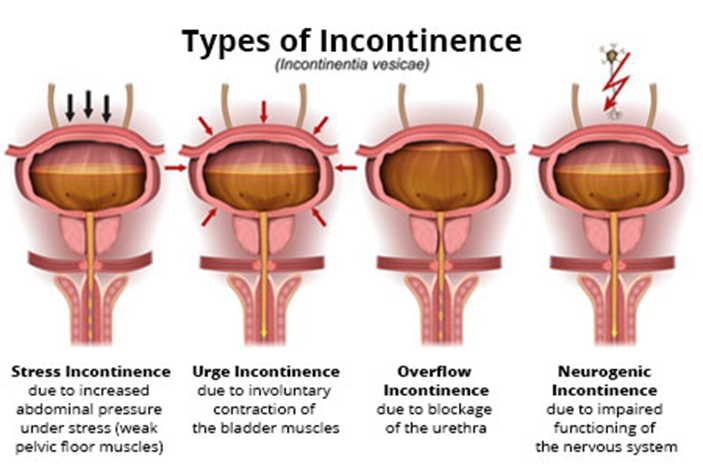A nurse is caring for a client who tells the nurse she experiences urinary incontinence when she sneezes. The nurse recognizes this is an expected finding for which of the following types of incontinence?
Stress incontinence
Urge incontinence
Overflow incontinence
Reflex incontinence
The Correct Answer is A
A. Stress incontinence
Stress incontinence is the involuntary loss of urine during activities that increase intra-abdominal pressure, such as sneezing, coughing, laughing, or lifting heavy objects. In stress incontinence, the pelvic floor muscles are weakened, leading to inadequate support of the bladder and urethra. This results in leakage of urine during moments of increased pressure on the bladder.
B. Urge incontinence
Urge incontinence involves a strong and sudden urge to urinate, leading to involuntary urine loss. It is often associated with an overactive bladder and may not be related to increased abdominal pressure.
C. Overflow incontinence
Overflow incontinence occurs when the bladder is unable to empty completely, leading to constant dribbling of urine. It is often associated with conditions that obstruct urine flow, such as an enlarged prostate in men.
D. Reflex incontinence
Reflex incontinence is characterized by the involuntary loss of urine due to a reflex arc that bypasses normal control mechanisms. It is often associated with neurological conditions that affect bladder control.

Nursing Test Bank
Naxlex Comprehensive Predictor Exams
Related Questions
Correct Answer is D
Explanation
A. “I don’t take naps throughout the day.”
This statement suggests that the client avoids daytime napping, which is generally a positive sleep habit. Excessive daytime napping can interfere with nighttime sleep.
B. “I go to bed and get up at the same times each day.”
Maintaining a consistent sleep schedule is a key component of good sleep hygiene. Going to bed and waking up at the same times helps regulate the body's internal clock.
C. “I have a small snack and take a bath before going to bed each day.”
Having a light snack and engaging in a relaxing activity like a bath before bedtime can contribute to a more conducive sleep environment. However, the type and timing of the snack should be considered.
D. “I watch television until I fall asleep at night.”
This statement may indicate a need for further instruction. Watching television right before bedtime, especially until falling asleep, can be counterproductive to good sleep hygiene due to the stimulating effects of the screen's blue light.
Correct Answer is B
Explanation
A. “I wish I didn’t have to attach the electrodes to my skin.”
This statement reflects a common sentiment. Attaching electrodes to the skin is part of using TENS, and it's a non-invasive procedure where electrodes are placed on the skin surface to deliver electrical impulses for pain relief.
B. “It’s unfortunate that I have to be in the hospital for this treatment.”
This statement indicates a need for further teaching. TENS is typically an outpatient treatment, and individuals can use TENS units at home after receiving appropriate instructions and training. It does not require being in the hospital.
C. “I’ll need to shave the hair off the skin where I place the electrodes.”
This statement is accurate. To ensure proper contact and effectiveness, it is often recommended to shave or trim the hair in the area where the electrodes will be placed.
D. “I hope I don’t have to take as many pain pills.”
This statement reflects an understanding of the potential benefits of TENS. TENS is used as an adjunct therapy to help manage pain, and one of its goals may be to reduce the need for pain medications.
Whether you are a student looking to ace your exams or a practicing nurse seeking to enhance your expertise , our nursing education contents will empower you with the confidence and competence to make a difference in the lives of patients and become a respected leader in the healthcare field.
Visit Naxlex, invest in your future and unlock endless possibilities with our unparalleled nursing education contents today
Report Wrong Answer on the Current Question
Do you disagree with the answer? If yes, what is your expected answer? Explain.
Kindly be descriptive with the issue you are facing.
